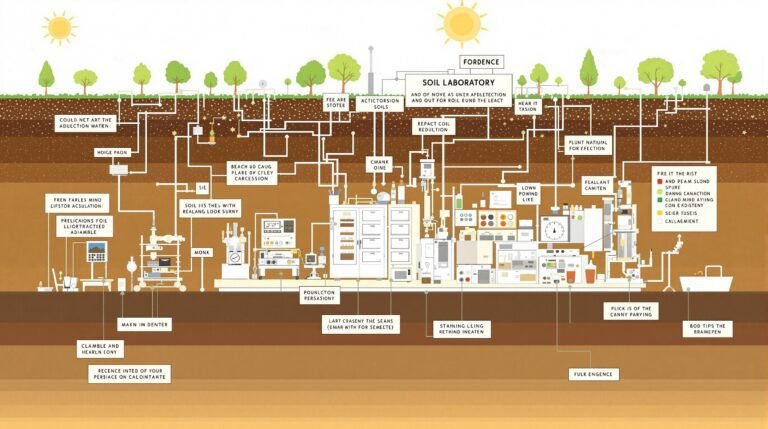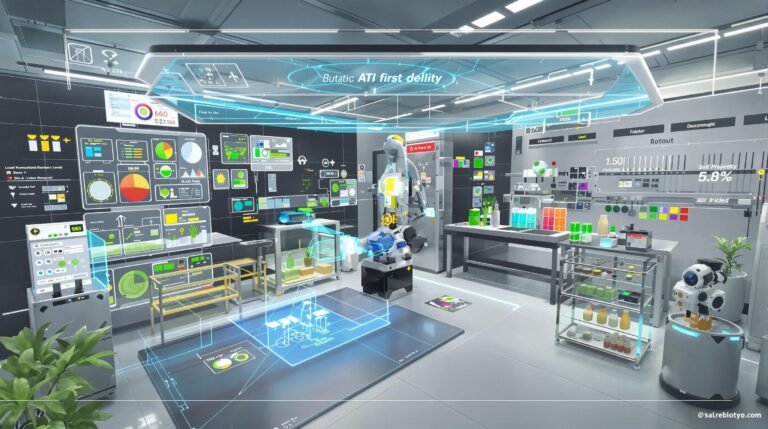The Essential Guide to Soil Laboratory Testing in Civil Engineering
Published in: 19 February 2024 (Wednesday)
Advancing Geotechnical Analysis for Robust Infrastructure Development
Soil laboratory testing forms the bedrock of civil engineering projects, providing critical data that informs design decisions and ensures the safety and longevity of structures. As urban development continues to push boundaries, the importance of thorough soil analysis has never been more pronounced. This comprehensive guide delves into the intricacies of soil laboratory testing, exploring its significance, methodologies, and the innovative approaches that are shaping the future of geotechnical engineering.
The Foundations of Soil Laboratory Testing
Soil laboratory testing is a complex process that involves analyzing soil samples to determine their physical and chemical properties. These tests provide crucial information about soil strength, compressibility, permeability, and other characteristics that directly impact the design and construction of infrastructure projects. EEDAS, a leader in geotechnical engineering solutions, has been at the forefront of soil laboratory testing for years. Their advanced geotechnical services have contributed to numerous successful projects across various industries. The process of soil laboratory testing typically involves several stages: 1. Sample Collection: Obtaining representative soil samples from the project site. 2. Sample Preparation: Processing the samples for various tests. 3. Physical Property Tests: Determining soil composition, grain size distribution, and moisture content. 4. Mechanical Property Tests: Assessing soil strength, compressibility, and shear resistance. 5. Chemical Analysis: Evaluating soil pH, organic content, and presence of contaminants. 6. Data Interpretation: Analyzing test results to inform engineering decisions.

The Significance of Accurate Soil Testing
Accurate soil testing is paramount in civil engineering projects. It serves as the foundation for informed decision-making and helps mitigate potential risks associated with soil-related issues. Here’s why soil laboratory testing is crucial: 1. Foundation Design: Soil properties determine the type and depth of foundations required for structures. 2. Slope Stability Analysis: Soil strength parameters are essential for assessing the stability of natural and man-made slopes. 3. Pavement Design: Soil characteristics influence the thickness and composition of road pavements. 4. Earthquake Engineering: Soil behavior under seismic loads is critical for designing earthquake-resistant structures. 5. Environmental Assessment: Soil testing helps identify contaminants and assess their impact on construction and the environment. EEDAS’s expertise in soil laboratory testing has been instrumental in numerous high-profile projects, ensuring the safety and stability of structures in diverse geological conditions.
Advanced Techniques in Soil Laboratory Testing
The field of soil laboratory testing is constantly evolving, with new technologies and methodologies emerging to enhance accuracy and efficiency. Some of the advanced techniques employed by leading firms like EEDAS include: 1. Triaxial Testing: This sophisticated test provides detailed information about soil strength and stress-strain behavior under various loading conditions. 2. Resonant Column Testing: Used to determine dynamic soil properties, crucial for earthquake engineering and machine foundation design. 3. Cyclic Simple Shear Testing: Simulates the behavior of soil under repeated loading, important for assessing liquefaction potential. 4. Bender Element Testing: Measures small-strain shear modulus of soil, vital for predicting soil behavior under dynamic loads. 5. X-ray Diffraction (XRD) Analysis: Identifies the mineralogical composition of soil, which can significantly influence its engineering properties.

These advanced techniques allow for a more comprehensive understanding of soil behavior, leading to more accurate predictions and safer designs. EEDAS’s civil engineering expertise extends to the application of these cutting-edge methodologies in real-world projects.
Challenges and Solutions in Soil Laboratory Testing
Despite advancements in technology, soil laboratory testing still faces several challenges. Understanding these challenges and implementing effective solutions is crucial for ensuring reliable test results.
Sample Disturbance
Challenge: Obtaining and transporting undisturbed soil samples can be difficult, potentially altering the soil’s in-situ properties. Solution: EEDAS employs specialized sampling techniques such as thin-walled tube samplers and frozen sampling to minimize disturbance. They also utilize in-situ testing methods like cone penetration tests (CPT) to complement laboratory data.
Variability in Soil Composition
Challenge: Soil can vary significantly even within small areas, making it challenging to obtain representative samples. Solution: Implementing a comprehensive site investigation plan with strategically located boreholes and employing statistical analysis methods to account for soil variability.
Time and Cost Constraints
Challenge: Thorough soil testing can be time-consuming and expensive, potentially impacting project schedules and budgets. Solution: EEDAS optimizes testing programs by prioritizing critical parameters and utilizing rapid testing techniques where appropriate. They also leverage their extensive database of regional soil properties to complement site-specific testing.
Interpretation of Complex Data
Challenge: Soil behavior is complex, and interpreting test results requires expertise and experience. Solution: EEDAS’s team of experienced geotechnical engineers uses advanced data analysis tools and numerical modeling to interpret test results accurately. They also maintain a knowledge-sharing platform to leverage collective expertise across projects.
Environmental Concerns
Challenge: Soil testing may involve chemicals and processes that could potentially impact the environment. Solution: Implementing environmentally friendly testing procedures and proper waste management practices. EEDAS is committed to sustainable engineering practices in all aspects of their operations. By addressing these challenges head-on, EEDAS ensures that their soil laboratory testing services provide reliable and actionable data for their clients’ projects.
The Future of Soil Laboratory Testing
As technology continues to advance, the future of soil laboratory testing looks promising. Several emerging trends are set to revolutionize the field: 1. Artificial Intelligence and Machine Learning: These technologies are being integrated into data analysis processes, allowing for more accurate predictions of soil behavior based on historical data and test results. 2. Real-time Monitoring: Advanced sensors and IoT devices are enabling continuous monitoring of soil properties during and after construction, providing valuable data for long-term asset management. 3. Virtual and Augmented Reality: These technologies are being used to visualize complex soil data and site conditions, enhancing understanding and decision-making processes. 4. Nanotechnology: The application of nanotechnology in soil testing is opening up new possibilities for detecting minute changes in soil properties and contaminants. 5. Sustainable Testing Methods: There’s a growing focus on developing eco-friendly testing procedures that minimize environmental impact while maintaining accuracy.

EEDAS is actively investing in research and development to stay at the forefront of these technological advancements, ensuring that their clients benefit from the latest innovations in soil laboratory testing.
Collaboration and Innovation in Soil Testing
The field of soil laboratory testing is increasingly characterized by collaboration between industry, academia, and regulatory bodies. This collaborative approach is driving innovation and standardization in testing methodologies. EEDAS actively participates in industry forums and research partnerships, contributing to the development of new testing standards and sharing best practices. Their involvement in collaborative projects has led to significant advancements in areas such as: 1. Development of new testing protocols for emerging contaminants 2. Standardization of testing procedures for novel construction materials 3. Creation of open-source databases for regional soil properties 4. Advancement of remote sensing techniques for preliminary soil assessments By fostering a culture of collaboration and continuous learning, EEDAS ensures that their soil laboratory testing services remain at the cutting edge of geotechnical engineering.

Conclusion
Soil laboratory testing stands as a critical component in the realm of civil engineering, providing the essential data that underpins safe, efficient, and sustainable infrastructure development. As we’ve explored throughout this guide, the field is characterized by continuous innovation, addressing complex challenges with advanced technologies and methodologies. From the foundational principles to the cutting-edge techniques employed by industry leaders like EEDAS, soil laboratory testing continues to evolve, adapting to the changing needs of our built environment. The integration of artificial intelligence, real-time monitoring, and sustainable practices is set to further transform the landscape of geotechnical engineering. As we look to the future, the importance of accurate, comprehensive soil analysis will only grow. With urbanization accelerating and climate change posing new challenges, the insights gained from soil laboratory testing will be crucial in creating resilient, sustainable infrastructure. For those seeking to delve deeper into the world of geotechnical engineering or requiring expert soil testing services, EEDAS stands ready to provide industry-leading expertise. Their commitment to innovation, sustainability, and technical excellence positions them as a valuable partner in navigating the complexities of soil mechanics and foundation engineering. To learn more about EEDAS’s comprehensive range of geotechnical services or to discuss your project needs, visit their website or contact their engineering team directly. In the dynamic field of civil engineering, staying informed and partnering with experienced professionals is key to achieving project success and contributing to a more sustainable built environment.

